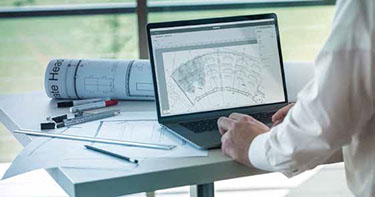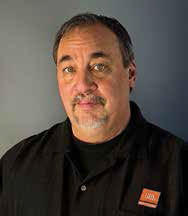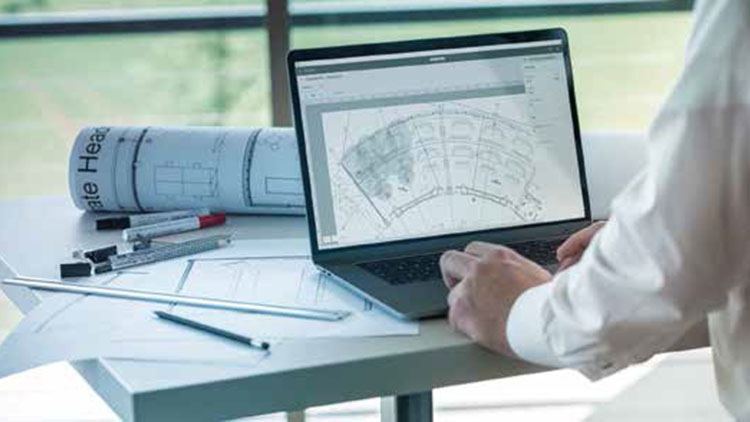If the sound of your line array installations has you feeling down, it’s time to go into analysis. Not the kind with a couch and a psychologist—for AV integrators and consultants, this calls for audio systems design software suites.
These increasingly powerful solutions excise intuition in producing a system with full frequency response and high speech intelligibility, tapping predictive science to tune the best possible live sound installations and conference rooms. Used knowledgeably, today’s tools can create a 3D model faster than ever, and better match that model’s acoustic performance to a space by accurately mapping key variables including coverage, loudness, and speech intelligibility, while accounting for varied room configurations and listener positions.

Shure’s Designer software is designed to allow integrators and consultants to better estimate the number of MXA910 Ceiling Array microphones needed and then configure their lobe placements before they arrive onsite.
“Systems integrators and consultants are always looking for tools to improve and streamline their workflows,” said Peter Herr, senior marketing manager for Shure. “Software-based design tools such as Shure’s Designer, for example, allow them to better estimate the number of MXA910 Ceiling Array microphones needed and then configure their lobe placements before they arrive onsite. With the time saved, they can focus their efforts by putting on headphones and fine-tuning a room system in a fraction of the time taken if they were starting the entire process onsite.”

Jay Fullmer, applications expert, Harman TSE/JBL Professional
According to Jay Fullmer, applications expert, Harman TSE/JBL Professional, the rise of audio system design software solutions coincides with the welcome decline of shoot-from-the-hip setups. “Those days are pretty much over,” he said. “In the past, system designs might have been pieced together through general experience, and designers would sometimes develop bad habits using the same product on a wide variety of audience geometries and acoustic environments because they had a high comfort level with them. This can lead to tendencies of using the same go-to items in their design toolbox.
“For live production companies in a theater-type or corporate event, the ability to very quickly define the array shape, with an articulated array, for instance, is extremely important. Having done some math beforehand, they can hang the array knowing what the optimum box-to-box splay angles should be, and what the attenuation should be for gain shading lower boxes in the array that are closer to the audience ear level. Being able to begin from a starting point that has had some preliminary work applied toward the final design is well worth it.”
And integrators aren’t the only ones who need what audio analyzers have to offer—clients increasingly want in on the info. “We tend to have a more educated end user out there these days, who quite often wants to see some sort of empirical data,” Fullmer noted. “They’re asking, ‘What’s the math behind this? What are the philosophies behind a given design?’ End users want to have some kind of proof, in many situations, that the design being suggested will actually perform as advertised.”
Adding to the appeal of audio software design analysis software—such as Harman’s JBL VERTEC Line Array Calculator II or CBT Calculator (for the Constant Bandwidth Technology Adjustable Coverage Line Array Column), or Shure’s Designer—is their expanded depth in every direction. Improved performance for these solutions can be measured by metrics including speed, accuracy, ease of use, resolution, IT system compatibility, and more.
“We’re seeing these tools become increasingly powerful but also more user-friendly at the same time, allowing for better collaboration on how a room design will operate on a day-to-day basis for the end client,” said Shure’s Herr. “Additionally, more AV system components and technologies now reside in the IT domain, and the ability for these design tools and their associated products to ‘play nice’ within that IT infrastructure is pivotal to a successful experience for IT managers and the eventual end users of the system.”
Meanwhile, integrators using Shure’s Designer can use it to configure multiple MXA910 Ceiling Arrays in a single meeting or conference space. “The software allows the user to optimize the coverage of these microphones ahead of time over an imported room layout image, without being connected to the actual hardware,” said Herr. “Once the user saves the configuration, each preset can then be easily uploaded to the MXA910s onsite, and even ported to multiple spaces/arrays where applicable.”
Like many of the analyzers offered by companies like JBL and Bose, Shure’s Designer suite is offered at no cost, with a license included alongside the system—a business decision that helps ensure the best possible results on a project. “By offering Designer free of charge, we’re empowering our customers to immediately incorporate the benefits of this software design tool into their workflows,” Herr added.
In other instances, the analysis software and the system itself are one, working adaptively together long after the initial installation, such as with Plantronics’ Habitat Soundscaping service. An intelligent acoustic management service, Habitat Soundscaping is designed to help transform distracting open office spaces into peaceful environments that facilitate increased focus and collaboration. Using nature-inspired audio and visuals, coupled with intelligent software to mitigate distractions due to speech, the system creates an immersive work experience.
“Habitat Soundscaping is a three-pillar system that is integrated and built into an office’s physical infrastructure, rather than a pure acoustic design software tool,” said Robert Manassero, product marketing manager for Habitat Soundscaping. “The first component is audio, which uses natural sounds, like the sound of flowing water, to help disperse the speech occurring around you in the workplace so that it isn’t distracting. Building on the calming influences of dispersed audio are the visual elements that strengthen the tie-in to nature. Based on a network of speakers and sensors scientifically distributed across the office area, a cloud-based software application dynamically manages sound levels in real time.”
Endowed with what Plantronics calls Intelligence and Health Check, the Habitat Soundscaping system automatically adjusts in real-time in order to adapt to noise throughout the workplace. “If the system notices a high level of intelligible speech, the biophilic audio operates on a higher level to minimize the impact of these conversations on those who are doing focus work,” Manassero said. “During quieter times, the audio automatically decreases. This makes the system highly adaptive, since different spaces will have different levels of conversation, all of which will vary over the course of the work day.”
In the case of suites requiring a more hands-on level of human intervention for installation or turning, Shure’s Peter Herr has some parting advice for integrators looking to boost their personal proficiency. “It’s an exciting time with all the software tools available to improve AV across all facets of the signal chain—but it can be overwhelming with everything out there,” he said. “From online webinars to in-person events, there are many training options available to stay on top of the latest and greatest software releases and make things easier.”
“Use audio systems design software as much as possible, and compare your results on the finished system to the estimations you made with the program if you want to improve,” Fullmer added. “And read the help file that comes with the program! I do a lot of high-level tech calls, and it seems that when people today get a new product, the first thing we do is set the documentation aside. Maybe that’s just a reflection of our immediate-gratification society, but with any of these programs it really helps to read the instructions.”
David Weiss (dwords.com) writes extensively about AV, audio, and broadcast technology.
